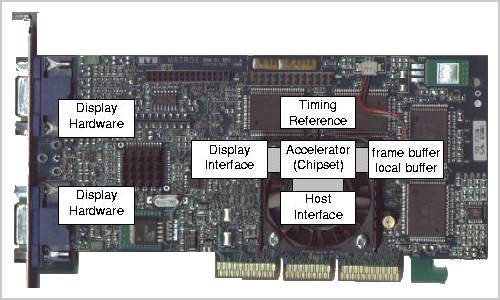KGIM
General
KGIM (Kernel Graphic Interface Module) is a kernel driver framework enabling the implementation of modular graphic drivers. HW of such drivers is supposed to be of the same kind, composed of: a clock and a ramdac for building the output signal, a chipset for controlling the host bus and a monitor to display the processed data/signal. The whole is linked by the board definition.
The purpose of KGIM is not to abstract the HW like the Display API does. But KGIM offers a convenient way to build graphic drivers from pieces of software already developed for HW components commonly integrated in graphic boards.
KGI Graphic Drivers: the paradigm
Under KGIM, graphic drivers are broken down into several submodules, each supposingly responsible for the management of an independent HW subcomponent of graphic boards (clock, ramdac, chipset). Additionaly the monitors have their own driver according to their technology (monosync, multisync, crt) and their charateristics.

See the KGIM source code layout for implementation details.
The Board
The board is the link between all the driver components. Currently this binding is static. It means that you must provide the description for your board at the link of the OS module. The board description is given in a spec file with the following syntax:
Board(Matrox, G450, Standard_SVGA)
#if Data
Begin
SubsystemID(0x102B, 0x0525)
Vendor("Matrox Graphics Inc")
Model("G450")
Driver(chipset, Matrox/Gx00, mgag_chipset)
Driver(ramdac, Matrox/Gx00, mgag_ramdac)
Driver(clock, Matrox/Gx50, Gx50_clock)
Driver(monitor, crt/crt, crt_monitor)
End
#endifIn the original KGI-0.9, the monitor line was not there and the monitor type was wired in the module code.
The Monitor
Monitors are defined by their characteristics in a .spec file:
Monitor(Iiyama, S702GT, Iiyama_S702GT)
#if Data
Begin
Contributor("foo bar<foobar@hotmail.com>")
Vendor("Iiyama")
Model("S702GT")
Flags(KGIM_MF_POWERSAVE)
MaxRes(1600, 1200)
Size(310, 232)
Type(KGIM_MT_ANALOG | KGIM_MT_RGB | KGIM_MT_CRT)
Sync(KGIM_ST_SYNC_NORMAL | KGIM_ST_SYNC_COMPOSITE |
KGIM_ST_SYNC_ON_GREEN | KGIM_ST_SYNC_VESA_DPMS |
KGIM_ST_SYNC_MULTISYNC | KGIM_ST_SYNC_0700_0300)
Bandwidth(0, 160000000)
hFreq(0, 27000, 96000)
vFreq(0, 50, 160)
End
#endifAlso, the monitor technology has to be known and specified in the board .spec (see above). Depending on the technology, the parameters given in the monitor .spec are used differently. Currently, only monosync and crt monitors are supported by the kgidrv driver suite.
Improvement proposal for KGIM
The downside of the above is the static allocation of monitors to graphic ports. Additionaly, allocation of graphic modules to KGI displays is wired too e.g one must provide the display id when loading the module. Obviously, this is not a good thing for loading a driver for multiple boards of the same kind...
On Linux, graphic driver <-> KGI display is done by module loading parameters (too much OS specific to my taste). On FreeBSD, no solution has been found yet.
HW devices vs display assignement
BeOS proposes for each kernel driver an entry in /dev with the PCI id and the HW slot the card is inserted in. This is the role of the publish_devices() routine: The driver is supposed to generate and publish a "unique" name for the card it is bound to. Usually the driver uses the manufacturer ID, card ID, bus number, slot number, and in some cases a function number, to generate it's "unique" name. Also of relevance is the physical slot the video card is seated in. Therefore creating unique names for two exact cards is not an issue, since they are seated in two different card slots [1].
I think we could use this too and propose in /dev such a device to take control of the driver after module load time. Typically, the KGI display registration would not take place at module load but rather through this new /dev API. Since KGI allows overload of display backends, this would enable a totally dynamic allocation of the HW to KGI resources (displays and thus focuses). This would serve as the find_device() call in the BeOS scheme, except that "driver hooks" are not given to the user but to KGI which is accessed by the user.
Monitor assignement
Monitors are not connected to displays or whatever highlevel objects but really to boards and even heads. Brian's "sink" term in [2] has this meaning exactly to show the basic principle. The same way board driver instances should be configurable regarding KGI displays by mean of a /dev interface, they should be configurable for monitor handling. And, when no other automatic mean is available (or safe) to detect the connected monitor, it should be possible to attach a monitor manually. Note that currently, the monitor is even specified in the board specification (.spec file) e.g before compiling and linking the module! Until a monitor is either detected automatically or manually attached, a default safe mode should be taken.
So, a driver module would be made of instances to be attached to KGI resources and/or monitors at any time.
Unavailable monitor drivers should not prevent from loading the boards. Then, monitor drivers should all publish the same set of routines and KGIM should give board drivers inquiry routines and wrappers to access the monitor(s) once they are loaded.
References
[1] "Writing Video Card Drivers In BeOS" by Rudolf Cornelissen (June 06th, 2003)
[2] "Proposal for Open Source Graphic Systems" by Brian S. Julin (2004)